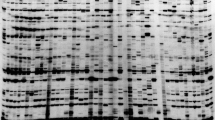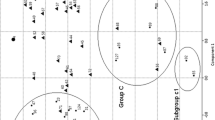Abstract
Retrotransposon-based markers, such as the inter-retrotransposon-amplified polymorphism (IRAP) and the retrotransposon microsatellite-amplified polymorphism (REMAP) are highly informative, multilocus, and reveal insertional polymorphisms among plant individuals. These markers have been used for evolutionary studies, genetic diversity assessment, DNA fingerprinting, genetic mapping linkage, and for the detection of genetic rearrangements induced by polyploidization. In this study, we used IRAP and REMAP markers to assess the genetic diversity among 51 old Portuguese durum wheat cultivars belonging to 27 botanical varieties and to define their genetic relationships. Five IRAP and four REMAP primer combinations were used. IRAP markers revealed 66.3% of polymorphism and an average of 18.4 bands per primer combination which ranged in size from 450 to 3,100 bp. The REMAP technique allowed the detection of 86.36% of inter-cultivar polymorphism and an average of 11 bands per primer combination. The molecular weight of the REMAP bands ranged from 250 to 2,750 bp. The durum wheat cultivars analyzed here belong to 27 botanical varieties of the subspecies Triticum turgidum subsp. turgidum L. [syn. T. turgidum] and Triticum turgidum L. subsp. durum [syn. T. durum] (Desf.) Husn.. Our results showed that the genetic variability assessed by both the IRAP and REMAP markers did not allow the clustering of the durum wheat cultivars according to their taxonomical criteria (subspecies or botanical variety) or homonymy. Nonetheless, these markers were useful for the assessment of genetic diversity at the individual level, for the definition of genetic relationships among cultivars, and for estimation of the genetic structure of the Old collection under analysis. The achieved data could be valuable for future experiments of DNA fingerprinting, genetic improvement, and germplasm conservation in wheat.






Similar content being viewed by others
References
Alavi-Kia SS, Mohammadi SA, Aharizad S, Moghaddam M (2008) Analysis of genetic diversity and phylogenetic relationships in Crocus genus of Iran using inter-retrotransposon amplified polymorphism. Biotechnol & Biotechnol EQ 22(2008/3):795–800
Bagulho F, Maçãs B, Coutinho J, Gonçalves MJ, Brites C (1995) Durum wheat in Portugal: status and potentialities. In: Fonzo N, Kaan F, Nachit M (eds) Options Méditerranéennes: Série A—Séminaires Méditerranées n. 22, CIHEAM-IAMZ. Durum wheat quality in the Mediterranean region, 17–19 Nov 1993, Zaragoza, Spain, pp 109–115
Bento M, Pereira HS, Rocheta M, Gustafson P, Viegas W, Silva M (2008) Polyploidization as a retraction force in plant genome evolution: sequence rearrangements in Triticale. PLoS ONE 3:e1402. doi:10.1371/journal.pone.0001402
Bento M, Gustafson P, Viegas W, Silva M (2010) Genome merger: from sequence rearrangements in triticale to their elimination in wheat–rye addition lines. Theor Appl Genet 121:489–497
Branco CJS, Vieira EA, Malone G, Kopp MM, Malone E, Bernardes A, Mistura CC, Carvalho FIF, Oliveira CA (2007) IRAP and REMAP assessments of genetic similarity in rice. J Appl Genet 48:107–113
Carvalho A, Lima-Brito J, Maçãs B, Guedes-Pinto H (2009) Genetic diversity and variation among botanical varieties of old Portuguese wheat cultivars revealed by ISSR assays. Biochem Genet 47:276–294
Carvalho A, Guedes-Pinto H, Martins-Lopes P, Lima-Brito J (2010) Genetic variability analysis in old Portuguese bread wheat cultivars assayed by IRAP and REMAP markers. Ann Appl Biol 156:337–345
Carvalho A, Guedes-Pinto H, Lima-Brito J (2011) Physical localization of NORs and ITS length variants in old Portuguese durum wheat cultivars. J Genet 90:95–101
Chadha S, Gopalakrishna T (2005) Retrotransposon-microsatellite amplified polymorphism (REMAP) markers for genetic diversity assessment of the rice blast pathogen (Magnaporthe grisea). Genome 48:943–945
Cömertpay G, Baloch F, Kilian B, Ülger A, Özkan H (2011) Diversity assessment of Turkish maize landraces based on fluorescent labelled SSR markers. Plant Mol Biol Rep. doi:10.1007/s11105-011-0332-3
Doyle JJ, Doyle JL (1987) A rapid DNA isolation procedure for small quantities of fresh leaf tissue. Phytochem Bull 19:11–15
Falush D, Stephens M, Pritchard JK (2007) Inference of population structure using multilocus genotype data: dominant markers and null alleles. Mol Ecol Notes 7:574–578
Felsenstein J (1985) Confidence limits on phylogenies: an approach using the bootstrap. Evolution 39:783–791
Hedges SV (1992) The number of replications needed for accurate estimation of the bootstrap P value in phylogenetic studies. Mol Biol Evol 9:366–369
Jaccard P (1908) Nouvelles recherches sur la distribution florale. Bulletin de la Société Vaudoise des Sciences Naturelles 44:223–270
Kalendar R, Schulman AH (2006) IRAP and REMAP for retrotransposon-based genotyping and fingerprinting. Nat Protoc 1:2478–2484
Kalendar R, Grob T, Regina M, Suoniemi A, Schulman A (1999) IRAP and REMAP: two retrotransposon-based DNA fingerprinting techniques. Theor Appl Genet 98:704–711
Kalendar R, Tanskanen J, Immonen S, Nevo E, Schulman AH (2000) Genome evolution of wild barley (Hordeum spontaneum) by BARE-1 retrotransposon dynamics in response to sharp microclimatic divergence. Proc Natl Acad Sci USA 97:6603–6607
Leigh F, Kalendar R, Lea V, Lee D, Donini P, Schulman AH (2003) Comparison of the utility of barley retrotransposon families for genetic analysis by molecular marker techniques. Mol Genet Genomics 269:464–474
Mandoulakani BA, Piri Y, Darvishzadeh R, Bernoosi I, Jafari M (2011) Retroelement insertional polymorphism and genetic diversity in Medicago sativa populations revealed by IRAP and REMAP markers. Plant Mol Biol Rep. doi:10.1007/s11105-011-0338-x
Manninen O, Kalendar R, Robinson J, Schulman AH (2000) Application of BARE-1 retrotransposon markers to the mapping of a major resistance gene for net blotch in barley. Mol Gen Genet 264:325–334
Nei M (1987) Molecular evolutionary genetics. Columbia University Press, New York
Peakall R, Smouse PE (2006) Genalex 6: genetic analysis in Excel. Population genetic software for teaching and research. Mol Ecol Notes 6:288–295
Rohlf FJ (1998) NTSYS-pc ver. 2.02. Numerical taxonomy and multivariate analysis system. Exeter Publishing, Setauket
Saeed A, Hoysepyan H, Darvishzadeh R, Imtiaz M, Panguluri S, Nazaryan R (2011) Genetic diversity of Iranian accessions, improved lines of chickpea (Cicer arietinum L.) and their wild relatives by using simple sequence repeats. Plant Mol Biol Rep. doi:10.1007/s11105-011-0294-5
Saeidi H, Rahiminejad MR, Heslop-Harrison JS (2008) Retroelement insertional polymorphisms, diversity and phylogeography within diploid, D-genome Aegilops tauschii (Triticeae, Poaceae) sub-taxa in Iran. Ann Bot 101:855–861
Swapna M, Sivaraju K, Sharma R, Singh N, Mohapatra T (2011) Single-strand conformational polymorphism of EST-SSRs: a potential tool for diversity analysis and varietal identification in sugarcane. Plant Mol Biol Rep 29:505–513
Tanya P, Taeprayoon P, Hadkam Y, Srivines P (2011) Genetic diversity among Jatropha and Jatropha-related species based on ISSR markers. Plant Mol Biol Rep 29:252–264
Uzun A, Yyesiloglu T, Polat I, Aka-Kacar Y, Gulsen O, Yildirim B, Tuzcu O, Tepe S, Canan I, Anil S (2011) Evaluation of genetic diversity in lemons and some of their relatives based on SRAP and SSR markers. Plant Mol Biol Rep 29:693–701
Vargas-Ponce O, Pérez-Álvarez L, Zamora-Tavares P, Rodríguez A (2011) Assessing genetic diversity in Mexican husk tomato species. Plant Mol Biol Rep 29:733–738
Vasconcellos JC (1933) Trigos Portugueses ou de há muito cultivados no País (subsídios para o seu estudo botânico). Separata do Boletim de Agricultura. Ano I–Números 1 e 2; 1ª Série, Lisbon, Portugal, 150 pp
Vicient CM, Kalendar R, Anamthawat-Jónsson K, Suoniemi A, Schulman AH (1999) Structure, functionality, and evolution of the BARE-1 retrotransposon of barley. Genetica 107:53–63
Xie R-J, Zhou J, Wang G-Y, Zhang S-M, Chen L, Gao Z-S (2011) Cultivar identification and genetic diversity of Chinese bayberry (Myrica rubra) accessions based on fluorescent SSR markers. Plant Mol Biol Rep 29:554–562
Yap IV, Nelson RJ (1996) Winboot: a program for performing bootstrap analysis of binary data to determine the confidence limits of UPGMA-based dendrograms. IRRI, Manila
Zou M, Xia Z, Ling P, Zhang Y, Chen X, Wei Z, Bo W, Wang W (2011) Mining EST-derived SSR markers to assess genetic diversity in cassava (Manihot esculenta Crantz). Plant Mol Biol Rep. doi:10.1007/s11105-011-0299-0
Acknowledgments
This work was supported by the PTDC/AGR-GPL/65876/2006 project and the Ph.D. grant SFRH/BD/17348/2004, both financed by the Portuguese Foundation for Science and the Technology (FCT).
Author information
Authors and Affiliations
Corresponding author
Rights and permissions
About this article
Cite this article
Carvalho, A., Guedes-Pinto, H. & Lima-Brito, J.E. Genetic Diversity in Old Portuguese Durum Wheat Cultivars Assessed by Retrotransposon-Based Markers. Plant Mol Biol Rep 30, 578–589 (2012). https://doi.org/10.1007/s11105-011-0367-5
Published:
Issue Date:
DOI: https://doi.org/10.1007/s11105-011-0367-5




